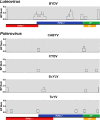Long-term evolution of the Luteoviridae: time scale and mode of virus speciation
- PMID: 20375155
- PMCID: PMC2876656
- DOI: 10.1128/JVI.02160-09
Long-term evolution of the Luteoviridae: time scale and mode of virus speciation
Abstract
Despite their importance as agents of emerging disease, the time scale and evolutionary processes that shape the appearance of new viral species are largely unknown. To address these issues, we analyzed intra- and interspecific evolutionary processes in the Luteoviridae family of plant RNA viruses. Using the coat protein gene of 12 members of the family, we determined their phylogenetic relationships, rates of nucleotide substitution, times to common ancestry, and patterns of speciation. An associated multigene analysis enabled us to infer the nature of selection pressures and the genomic distribution of recombination events. Although rates of evolutionary change and selection pressures varied among genes and species and were lower in some overlapping gene regions, all fell within the range of those seen in animal RNA viruses. Recombination breakpoints were commonly observed at gene boundaries but less so within genes. Our molecular clock analysis suggested that the origin of the currently circulating Luteoviridae species occurred within the last 4 millennia, with intraspecific genetic diversity arising within the last few hundred years. Speciation within the Luteoviridae may therefore be associated with the expansion of agricultural systems. Finally, our phylogenetic analysis suggested that viral speciation events tended to occur within the same plant host species and country of origin, as expected if speciation is largely sympatric, rather than allopatric, in nature.
Figures



References
-
- Barrell, B. G., G. M. Air, and C. A. Hutchison III. 1976. Overlapping genes in bacteriophage φX174. Nature 264:34-41. - PubMed
-
- Beuve, M., M. Stevens, H.-Y. Liu, W. M. Witermantel, S. Hauser, and O. Lemaire. 2008. Biological and molecular characterization of an American sugar beet-infecting Beet western yellows virus isolate. Plant Dis. 92:51-60. - PubMed
-
- Blok, J., A. Mackenzie, P. Guy, and A. Gibbs. 1987. Nucleotide sequence comparisons of Turnip yellow mosaic virus isolates from Australia and Europe. Arch. Virol. 97:283-295. - PubMed
-
- Botstein, D. 1980. A theory of modular evolution for bacteriophages. Ann. N. Y. Acad. Sci. 354:484-491. - PubMed
Publication types
MeSH terms
Substances
Grants and funding
LinkOut - more resources
Full Text Sources

